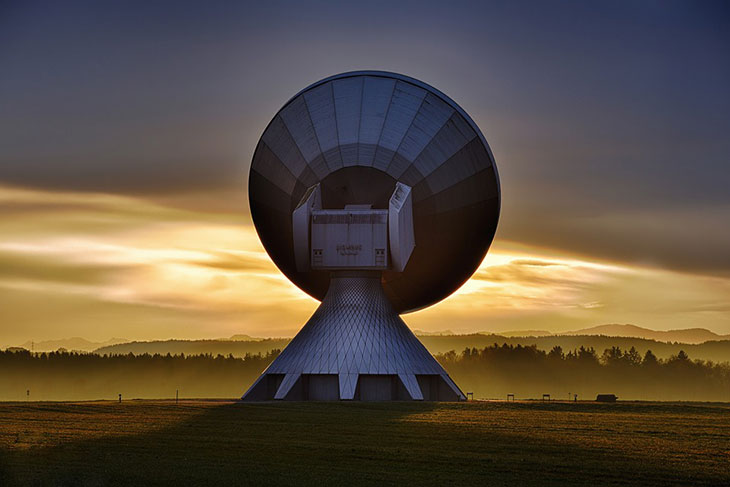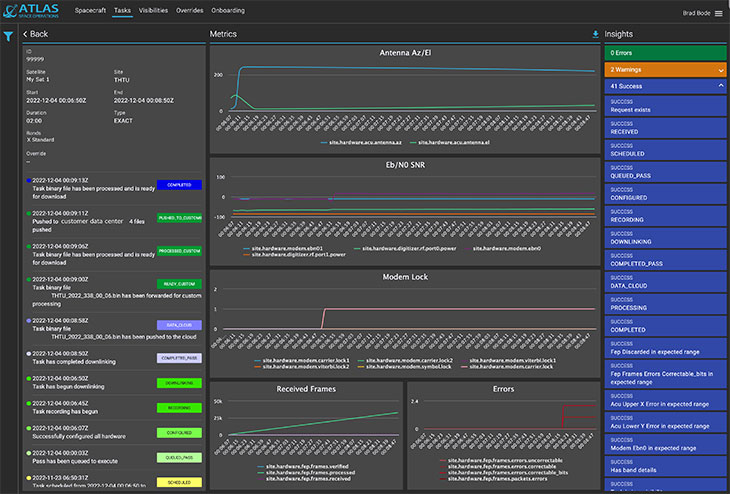ALEXANDRIA, Va. — The need for ground coverage is only increasing with the growing number of satellite operators in LEO and MEO. Ground station-as-a-service (GSaaS) has helped meet this demand and shaken up the industry by enabling greater access to space data.
“I would say [ground station-as-a-service] was disruptive and it will continue to be disruptive because it’s opened up space to more commercial industry,” Atlas Space Operations CTO and CIO Brad Bode told Constellations. “Now it’s just a matter of scaling.”
The more space has been disaggregated into services, the more it has allowed different players to focus on their core competencies. Satellite operators can gather and analyze data to provide new insights and products, instead of maintaining hardware or using root cause analysis to understand why a pass was unsuccessful.
 Ground station-as-a-service provides easier, less expensive access to space. Satellite operators share existing ground infrastructure and pay by the pass or by the minute.
Ground station-as-a-service provides easier, less expensive access to space. Satellite operators share existing ground infrastructure and pay by the pass or by the minute.
At the same time, GSaaS has been raising expectations of ground service. The model of providing customers an RF feed through a cable is increasingly outmoded. Ground services today are more software-based and cloud-native. Many users want anytime, anywhere access to their data and the ability to spin up service in days and weeks, not years.
According to Bode, ground service providers who resist these changes will soon find themselves falling behind the market.
“If you don’t have a stellar software team and if you’re not capable of updating your software multiple times per week, I think it’s going to be very difficult to keep pace,” he explained.
That’s easier said than done. The time and investment required to train a team of developers, produce software and stand up cloud-based access to an antenna are intensive. Organizations hoping to stay on track need to start their “software journey now, if not two years ago,” Bode continued.
For organizations that own only a few antennas or want to remain focused on their core competencies, that may not be worth the cost. As a result, more antenna operators are turning to existing GSaaS providers who offer that support.
“We’ll see some consolidation under one umbrella,” Bode said of GSaaS offerings. “There will be a lot of antenna providers deciding to offer their service through someone else, which is what we’re seeing on our system right now.”
Atlas was founded in 2015 and was one of the earliest developers of GSaaS, before the panoply of space-as-a-service offerings became well known. The company currently owns eight antennas, has integrated with five others and is planning further expansion in the coming months.
Different GSaaS Models
At its most basic level, GSaaS is like Airbnb for antennas. Service providers either own the ground sites or act as an intermediary working with antenna owners to sell excess capacity—or often a combination of the two.
Instead of investing in a dedicated ground site, satellite operators share the existing infrastructure and pay for data by the pass or by the minute. Currently, 70% of GSaaS customers are Earth observing satellites. The model makes it easier and less costly for satellite operators to scale and shifts investment from CAPEX to OPEX.
 Atlas’ Freedom Software Platform is a global ground management system with an intuitive user interface that makes communicating with satellites simpler, faster and more economical than ever before. (Source: Atlas Space Operations)
Atlas’ Freedom Software Platform is a global ground management system with an intuitive user interface that makes communicating with satellites simpler, faster and more economical than ever before. (Source: Atlas Space Operations)
There are a few standard functions within GSaaS, like uplink and downlink scheduling and data access. Otherwise, providers offer a range of services and delivery methods. At one end, is a model more analogous to a landlord situation than an Airbnb. In this model, GSaaS providers sell ground infrastructure or allow operators to install and integrate their own hardware at a ground site. Australia’s Capricorn Space uses this model (in addition to selling airtime on its network) and has described it as effectively giving customers their “own Australian ground station…within a very short period of time.”
Another model abstracts customers away from the physical ground site and delivers digitized RF over a cloud. AWS and Microsoft Azure are primarily in the business of data and support digital RF transmission, storage and processing. Another similar approach pre-processes data before streaming it to the cloud.
Atlas describes its approach as “ground software-as-a-service.” Satellite operators undergo an onboarding process with the cloud-based software, after which they can schedule passes, collect encrypted data and receive analyzed metrics about the ground site to aid in decision-making.
Winners and Losers?
There are signs of slower growth in the market. GSaaS operators generated $210 million in 2021, with commercial satellite operators driving two-thirds of that revenue. According to Euroconsult, the GSaaS market grew at 8.5% CAGR over the last five years. That growth rate is expected to slow to a more modest 3.3% over the next five years.
As the broader satellite market experiences consolidation, Bode anticipates something similar will happen around the various GSaaS options.
“I think that’s what we’re seeing today is the shakeout of all these different business models. Some will succeed some will fail,” Bode said.
Not every solution can easily scale to growing demand or accommodate the schedules of satellite operators with dynamic, fast-changing mission needs. Users have different security requirements, antenna frequency needs and service expectations. The process and ease of integrating with ground sites is also important, as well as the functionality and simplicity of the user interface.
The evolution of GSaaS is also occurring within a bigger, disaggregated as-a-service market. Service providers now offer everything from satellite bus manufacturing and payload integration to mission control, to data management and launch and in-orbit servicing. At the same time, providers are also competing against large verticals, some of which have been offering spin-off services for decades.
The Next Steps
The ground segment is in a period of transformation. The challenge for companies like Atlas and other market disruptors is to continue to stay ahead of trends in the ground segment and industry as a whole.
 The growing number of LEO and MEO constellations is driving demand for ground stations and flexible GSaaS. (Source: ESA)
The growing number of LEO and MEO constellations is driving demand for ground stations and flexible GSaaS. (Source: ESA)
Part of that is identifying the challenges in the existing market. For example, Bode noted that spectrum allocation remains one of the most time-consuming processes for satellite operators when they set up ground service. Depending on the country and operator, it can take almost a year to get regulatory approval. The U.S. FCC is currently revisiting its process for satellite licensing and will meet on the issue later this month.
Some ground infrastructure providers are addressing the regulatory challenge by shifting to higher, less occupied frequency bands beyond Ka. Others are looking at the feasibility of optical communication, which have less stringent regulations than RF and higher bandwidth, but more technical hurdles, particularly for space-to-ground.
Atlas has been involved in optical communications and space-based data relay for several years and is working with government and commercial partners to advance the technology.
“I’m excited about what’s coming and the work we’re doing to add new features to our [GSaaS] system but also looking further ahead so we can be a disrupter in future technologies that are going to help our customers,” Bode said.
Explore More:
Podcast: Ground Station-as-a-Service, Smallsat Growth and Cloud Security
Podcast: Space-as-a-Service, 3D Printed Satellites and Spectrum Licensing
BCG Space Executive Explains Growth Trends for Value Added Space Services
Affordability Is Transforming the Satellite Industry
